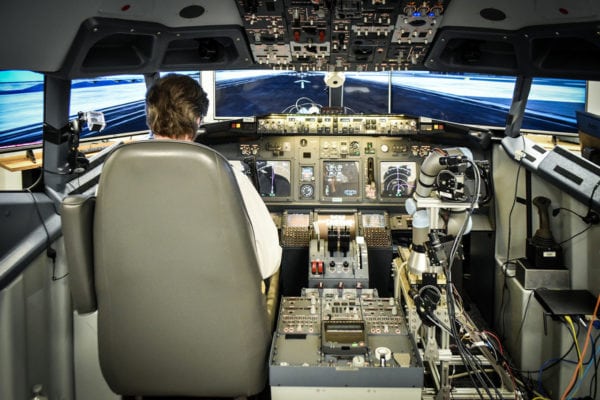
Pilot, ALIAS co-pilot in 737 simulator. Photo: Aurora Flight Sciences.
Aurora Flight Sciences continued to push the boundaries of what might be possible in future commercial aircraft cockpits with the most recent successful flight demonstration of its work as part of Defense Advanced Research Projects Agency (DARPA)’s Aircrew Labor In-Cockpit Automation System (ALIAS) program. During a demonstration on a Boeing 737-800NG simulator at the U.S. Transportation Dept.’s John A. Volpe National Transportation Systems Center in Cambridge, Massachusetts, Aurora’s ALIAS technology showcased its ability to utilize the existing 737 auto-landing system to autonomously land the aircraft safely in the event of pilot incapacitation.
DARPA describes ALIAS as a research and development program that is looking to take advantage of advances that have already been made in aircraft automation systems, including progress made in unmanned aircraft systems (UAS), to ultimately help reduce pilot workload, augment mission performance and improve aircraft safety. Under the program, DARPA envisions a future where a tailorable, drop-in, removable kit that would promote the addition of high levels of automation into existing aircraft, enabling operation with reduced onboard crew. After selecting Aurora and Lockheed Martin for the first two phases of the program, DARPA awarded Lockheed subsidiary Sikorsky a contract for the third phase back in January.
Aurora has also demonstrated ALIAS numerous times on aircraft in flight, most recently on the DA42. In the demonstration, ALIAS actualized DA42 cockpit procedures in real time and, overseen by an onboard safety pilot, conducted a fully automated landing at a simulated site at 3,000 ft. in altitude. The demonstration in Cambridge showed the technology’s ability to fly and land a Boeing 737 in a simulated environment.
“As we move toward fully automated flight from take-off to landing, we can reliably say that we have developed an automation system that enables significant reduction of crew workload,” said John Wissler, VP of research and development at Aurora Flight Sciences.